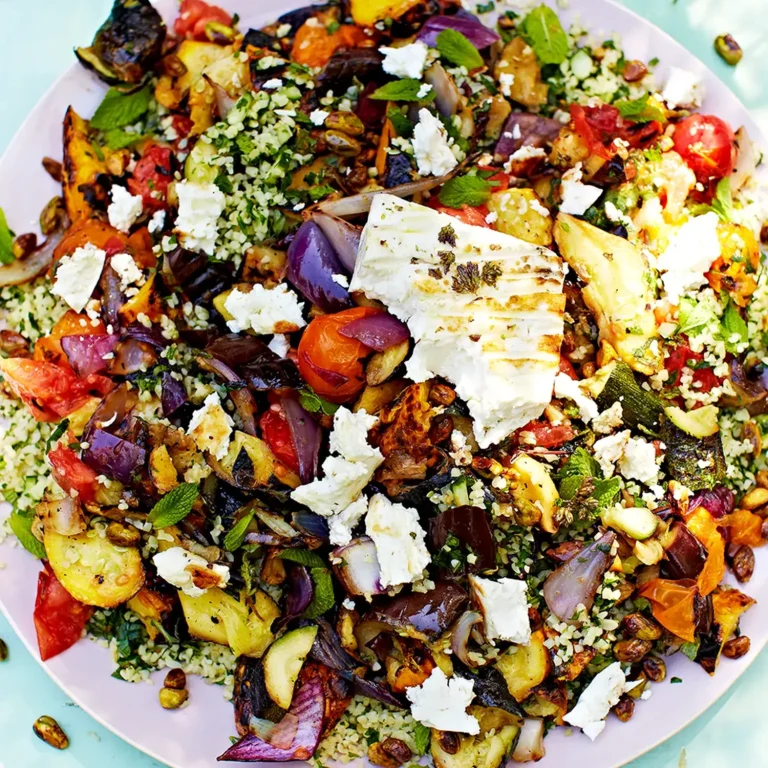
Arabic couscous salad
An easy veggie salad to serve at barbecues, or to batch cook for packed lunches.
Each serving provides 597 kcal, 21.5g protein, 70g carbohydrate (of which 13g sugars), 24g fat (of which 9g saturates), 10g fibre and 1.3g salt.
Prepare
less than 30 mins
Cook
10 to 30 mins
Serve
Serves 4
Dietary
Dairy-free
Egg-free
Healthy
Nut-free
Pregnancy-friendly
Vegan
Vegetarian
Ingredients
For the griddled veg
- 2 red onions, thickly sliced
- 2 courgettes, thickly sliced
- 1 aubergine, halved and thickly sliced
- 1 red and 1 yellow pepper, thickly sliced
- 4 tbsp olive oil
- salt and freshly ground black pepper
For the couscous
- 300g/10½oz couscous
- 300ml/10fl oz hot vegetable stock
- 4 tbsp roughly chopped flatleaf parsley
- 4 tbsp roughly chopped coriander
- 1 tbsp balsamic vinegar
- 200g/7oz feta, crumbled
- 1 red chilli, deseeded and finely chopped
Method
Heat a griddle pan over a high heat or prepare your barbecue until medium hot.
Mix the onions, courgettes, aubergine and peppers in a bowl and drizzle with the oil. Season well with salt and pepper and mix well.
Meanwhile, put the couscous in a large bowl. Pour in the stock, stir and cover with cling film. Soak for 12–15 minutes.
Griddle or barbecue the vegetables in batches for 8–10 minutes, or until just tender.
Fluff up the couscous with a fork, then add the herbs, vinegar and grilled vegetables. Stir well, then spoon onto a large platter. Sprinkle with the feta and chilli and serve.

Leg of lamb
Recipes come into being in strange ways. The fabulous Brazilian pit master and chef, André Lima de Luca, told me about a way he had for slow-cooking a shoulder of pork with (among many other ingredients) oregano, rosemary, orange and lemon. The thought and flavours percolated at the back of my mind for a while – and then I tried cooking a leg of lamb with them last Easter.
Prepare
30 mins to 1 hour
Cook
over 2 hours
Serve
Serves 6–8
Dietary
Dairy-free
Egg-free
Gluten-free
Nut-free
Ingredients
- 1 x 2kg/4lb 8oz leg of lamb
- small bunch oregano, leaves picked
- 1 tbsp rosemary leaves
- 4 garlic cloves, halved
- 1 lemon, zest and juice
- 1 orange, zest and juice
- 2 tbsp olive oil
- 2 tsp sea salt flakes
Method
Preheat the oven to 180C/160C Fan/Gas 4.
Sit the lamb in a large roasting tin, skin-side up, and use the tip of a sharp knife to make many incisions all over the skin.
Put the oregano, rosemary, garlic, lemon and orange zest, 2 tablespoons of lemon juice, 2 tablespoons orange juice, olive oil and salt in a bowl and blend using a stick blender (alternatively, use a small food processor). Spoon this over the lamb and rub in well. Leave at room temperature for 45 minutes.
Pour ½cm freshly boiled water into the bottom of the roasting tin and roast for 1 hour 40 minutes. Check after an hour to add more water if needed and cover with foil if the meat is beginning to catch. Just before the time is up, remove the lamb from the oven and check it is done to your liking, either using a probe and the temperatures listed in the tips below or piercing with a knife and taking a peek.
Remove the cooked lamb from the oven, cover loosely with foil, and rest for 15–30 minutes, checking every now and again, before transferring to a board to carve.
Recipe tips
The timing is based on your cooking a 2kg leg for 20 minutes per 500g plus 20 minutes, which will give you medium, that’s to say, pink lamb; if you want well-cooked lamb, then give it 30 minutes per 500g plus 30 minutes. However, ovens do vary, and it’s wise to use a temperature probe. I resisted for a long time, but now I get my probe out at every possible opportunity. But I don’t cook the meat to the temperature that I want it to be (for pink lamb, that would be 60C; for well done, 71C) because I find that the meat carries on cooking as it rests, and I’m always nervous of overcooking it. If you want your meat well-done, then this isn’t going to be a worry, but for pink meat I suggest that you take the lamb out when it reads 55C, and rest it, covered loosely in foil out of a draught for 15–30 minutes, testing with your probe to make sure you don’t carve it until it’s as you want it. But keep an eye, so it doesn’t go over, either.
You don’t exactly get a gravy out of the liquid at the bottom of the tin (the water stops the tin from burning and keeps the meat gorgeously tender) but taste it once the lamb’s rested, to see if you want to add a little freshly boiled water, and possibly a drop or two of honey, to give you some juices to pour over the carved meat.
©Copyright. All rights reserved.
We need your consent to load the translations
We use a third-party service to translate the website content that may collect data about your activity. Please review the details in the privacy policy and accept the service to view the translations.